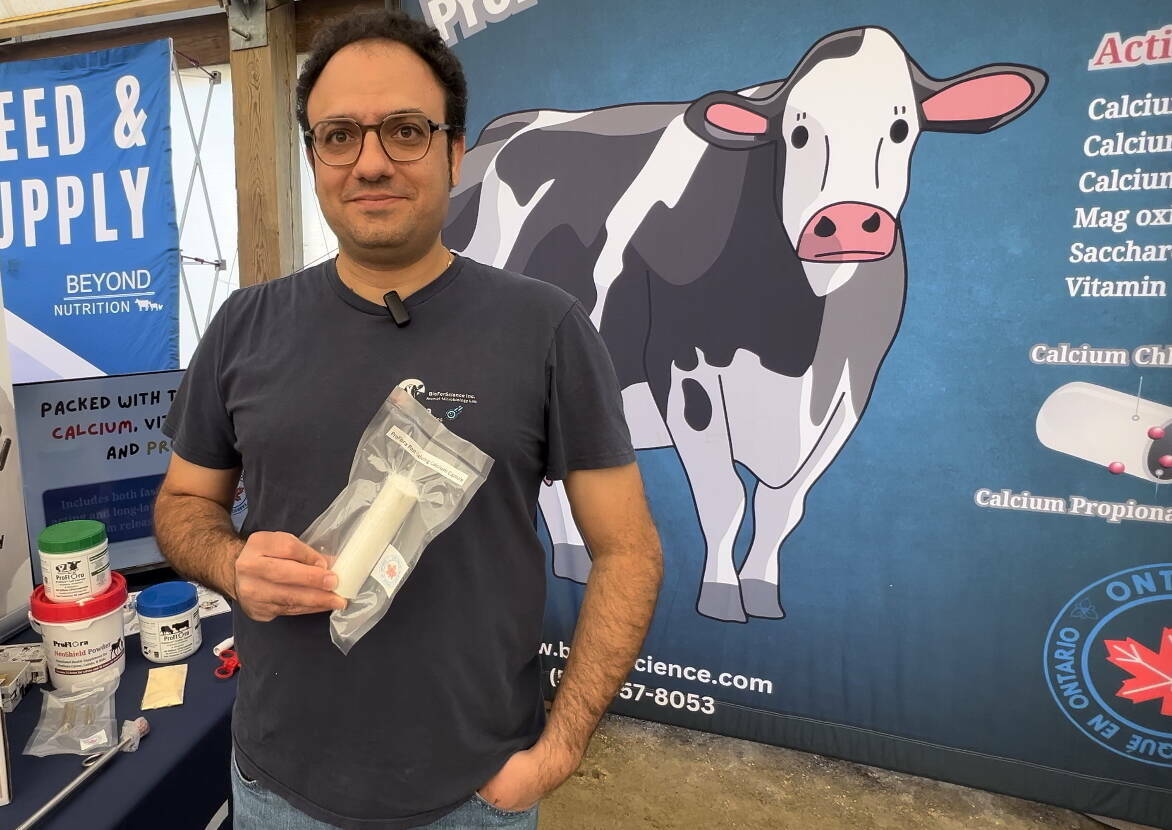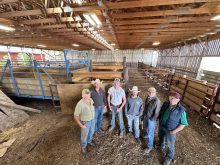Dave Milliner thinks the upcoming changes to federal regulations on livestock traceability are good but don’t go far enough.
He contends that much more could be done in the beef industry to improve the quality of the meat, the productivity of the animals, returns for farmers and choices for consumers.
“There’s no feedback loop — sure there’s a connection between the feedlot and the harvest plant, but there’s no connection back to the backgrounder or cow-calf operator,” he says.
Milliner is one of those cow-calf operators, raising purebred Simmentals in the Dundalk area of Grey County, Ont. He’s also on the board of directors of the Ontario Simmental Association and president of BIO, a producer organization that makes and sells a web-based livestock management system that provides genetic evaluations and performance reporting on individual animals and across breeds. He’s also the chief administrative officer for the Township of Southgate.
Read Also

Canadian Cattle Young Leaders, national Environmental Stewardship Award winner and more
Canadian beef industry news, including award winners and job changes.
“We need a circle of improvement,” he says. “If we could make a circle, I think, in the end, the consumer would be better served, the feedlots would get better cattle and there’d be more money in it for everyone.”
- Read more: Will more cattle data really mean more cash?
- Read more: Finally, a shirt-pocket tag reader that talks to your smartphone
In essence, Milliner thinks that the system could be used to increase the competitiveness of the Canadian beef industry, as well as protect animal health, public health and food safety, which is what the current regulations are designed to do.
The Canadian Food Inspection Agency (CFIA) has proposed changes to the Health of Animals Act regulations that include mandatory animal identification and movement reporting requirements for cattle, bison, sheep, pigs, goats and cervids (deer and elk). There have already been two rounds of consultations on these amendments in 2013 and 2015 with commodity groups, the provinces and other interested organizations. They will be pre-published for public comment for 75 days in spring 2018.
Milliner is convinced more could be done with the traceability system.
“A disruptive decision has to be made,” he says, noting that it would be an easy change because the information is already being collected — it’s just a matter of facilitating it and allowing it to flow through the system.
One barrier, as he sees it, is around information privacy, to which he says data on marbling in a cow, for example, shouldn’t be deemed private. A second problem is that people are afraid to pay more for good cattle. But, he reiterates, producing better cattle that command better prices throughout the system will mean more money for all.
Milliner is the third generation on his farm, which he took over from his father in 1992. He owns 200 acres and rents another 200.
His father switched from Herefords to Simmentals while Milliner was in college because of the better breed performance. Depending on the time of year, he has between 80 and 120 animals, usually around 90 cows and 15 to 20 bulls. He keeps the heifers and sells them when they’re bred. In late November, he had just sold 20 head of heifers and three bulls at the Marywood Classic sale in Listowel.
Most of his land is in hay, with 30 to 40 acres in mixed grains to feed the bred heifers.
Milliner sells into the commercial market and keeps comprehensive records on how each animal is performing. He scans all his cattle and gets ultrasound results so he knows what’s under the hide.
“We’ve always focused on meat quality,” he says, adding that he selects for the rib-eye area and marbling.
Over the years, the size of his cattle has definitely come down. In 2002, he had the Grand Champion female at the Royal Agricultural Winter Fair. But attitudes change, and while he says it’s nice to have pretty pictures of fat cattle at the fair, “pretty pictures don’t work on the farm.”
Milliner got involved in BIO because of his longstanding interest in genetic improvement. BIO, a not-for-profit producer co-operative, has grown from focusing strictly on beef genetic improvement in Ontario to providing a web-based livestock management system called bioTRACK that’s marketed around the world.
He pulls out the bioTRACK genetic score card of one heifer he recently bought out west and rattles off a whole range of numbers: she’s in the top 45 per cent of the breed for calving ease, top 40 per cent for birth weight, top 15 per cent for weaning gain and the top 15 per cent for yearling gain. She’s in the top 20 per cent for carcass weight and top 45 per cent for the rib-eye area and top 50 per cent for fat and top 75 per cent for marbling.
“What that tells me is how she’s doing inside the breed,” he says. “Then we also get cross-breed comparisons.”
The same heifer has a BIO dollar value of $4,182 and, across breeds, is in the top 12 per cent for genetic improvement, top two per cent for post-weaning gain and top five per cent for yearling gain. There are also scores for rib-eye, marbling, rib fat and rump fat.
He says that while he knows farmers are hard workers, not many like record-keeping, and bioTRACK makes that part of the job easier. In fact, with the introduction of blue-tooth technology in the new year, he says, keeping track will be easier than ever, and can be done right in the field.
In terms of how traceability should work for the beef industry, Milliner feels that the best place to make improvements is at the cow-calf level, since that’s where the conception decisions are made. His idea is to get into feed trials and genetic evaluations.
“If you can remove a half-pound of feed per pound of gain, that’s a lot of savings,” he says. “Feed efficiency is a huge thing that we could benefit from as an industry.”
He knows there would be logistical challenges. The beef cycle is 18 months to two years, versus six weeks for poultry, for example. There’s a lot more animal movement in the beef industry, a lot more people involved in raising the animals, and a lot more commingling of herds.
But Milliner argues that given the millions of dollars that farmers are already spending every year on RFID ear tags, there ought to be a way to leverage more information from the system for genetic improvement.
“It’s like a friend of mine says, when you buy a car, you don’t just look at the outside, you have to look under the hood,” he says. “With ultrasound results, we should be able to look under the hide of a cow we’re buying.”
He wants to know how the cattle he buys perform in terms of fat versus marbling, and points out that “we’re selling meat, not fat.”
Milliner says that, ultimately, improving beef quality would make the meat more attractive as a protein choice for consumers both in Canada and around the world.
















